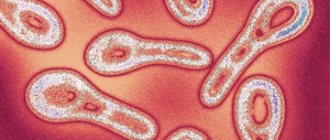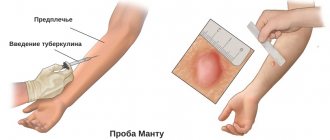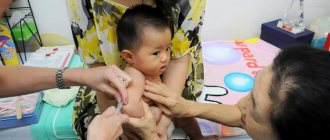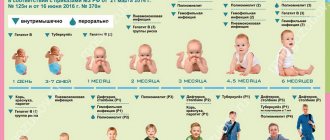November 14, 2018
DTP (adsorbed pertussis-diphtheria-tetanus vaccine) is one of the first places in the Russian national vaccination schedule
DPT (adsorbed pertussis-diphtheria-tetanus vaccine) is one of the first places in the Russian national vaccination schedule: the first course (three stages) is carried out at 2-3, 4-5 and 6 months. The interval between vaccinations should be at least 30 days. The next vaccination is at 18 months. At this stage, stable immunity against whooping cough, diphtheria and tetanus is formed for the next 6-10 years.
HOW Vaccination AFFECTS THE SPREAD OF INFECTIONS
Before the advent of the DTP vaccine in the 1950s, infections such as tetanus, diphtheria and whooping cough caused very serious illness and even death. According to statistics, 20% of children suffered from diphtheria, and by the age of two years, almost half of the cases were fatal. Child mortality from tetanus was even higher and reached 95%. And whooping cough was almost as common as ARVI - almost 100% of children suffered from it, with varying degrees of severity. The WHO estimates that since the start of a large-scale pertussis vaccination campaign in the 1950s and 1960s, the number of cases has dropped by 90%!
In Russia, statistics also show positive figures: in 2016, there were only two cases of diphtheria infection and three of tetanus. Only about 8,000 people had whooping cough - 1.7 cases per 100,000 people. When you compare this to 1958, when there were 475 reported cases of whooping cough per 100,000 people, the statistics speak for themselves: the vaccine has indeed helped minimize the spread of the infection.
The anti-vaccination campaign that began in the 1980s led to a decrease in vaccination coverage of the Russian population to 60%, and this almost immediately affected the incidence of many infections, including whooping cough. By 1993, the number of reported cases had increased 13-fold. After the 2000s, when active public education led to an increase in the number of people vaccinated, especially children, the picture changed again.
Is it necessary to do 4 DPTs?
Some parents think that after three vaccinations the child becomes completely and permanently protected from infection with diphtheria, tetanus and whooping cough bacilli. On the Internet on forums you can read that the fourth DTP vaccination can be tolerated by the child’s body worse than the previous ones.
Revaccination with DTP is considered mandatory.
But every parent has the right to write a refusal based on the provisions of the law. Doctors give the following arguments in favor of the fourth vaccination:
- DTP forms temporary immunity. After the third vaccine, antibodies are present in sufficient concentration in the body for 5 years. Closer to 6-7 years, the baby becomes more susceptible to infection with tetanus, whooping cough and diphtheria bacilli;
- at 6-7 years old, a child usually begins to go to school. There the baby actively contacts other children and teachers. Accordingly, his risk of contracting infectious viral pathologies increases;
- diphtheria and tetanus are dangerous diseases. Children are especially susceptible to them due to weak immunity. There are still no effective drugs for tetanus bacillus. Therefore, the risk of mortality from this disease is very high;
- In 15-20% of children vaccinated with three doses of DPT, a sufficient amount of antibodies in the blood is not detected after a year. This is due to the individual characteristics of the body. The fourth vaccination can determine the concentration of antibodies at 6 years of age by donating blood for analysis. As a rule, by this age, most children's defenses against diphtheria, tetanus and whooping cough have already been reduced. Therefore, the fourth DPT vaccination is recommended for everyone.
Komarovsky recommends not ignoring immunoprophylaxis if the child has no contraindications. The doctor notes that the consequences of infectious viral pathologies develop much more often and they are more dangerous than adverse reactions to vaccination, which can be quickly eliminated with medication.
WHAT DOES THE DPT VACCINE CONSISTE OF?
The DPT vaccine consists of three components: purified diphtheria toxoid, purified tetanus toxoid and killed pertussis bacilli. Because of the last component, it is also called whole cell. It is used only for young children, since the older the child becomes, the more acutely he reacts to the pertussis component of the vaccine. Therefore, WHO recommends using DPT for primary vaccination of children, and revaccination with softer, acellular alternatives, in which killed pertussis bacilli are replaced with fragments of the cell wall of these bacteria, and the cells themselves are destroyed during the manufacturing process of the vaccine. It is the acellular vaccine against pertussis, diphtheria and tetanus (AADT) that is recommended for use in children over 6 years of age and adults.
Children's DTP vaccination
The country has a National Preventive Vaccination Calendar, which reflects the types of vaccines and the optimal timing of vaccination. One of the first vaccinations that a baby receives at a very early age is the DPT vaccine. This is why a large number of questions arise: what kind of reaction might there be to the DTP vaccine, how to prepare a child for the vaccine, and how to react to certain changes in the child’s health after vaccination. What is DTP? The vaccine contains components of three dangerous infections of bacterial origin: whooping cough, tetanus and diphtheria. The abbreviation of the name includes the first letters of the names of infections and stands for Adsorbed Pertussis-Diphtheria-Tetanus Vaccine.
Today, several drugs are approved for use in the Russian Federation: this is a Russian-made vaccine that uses a pertussis component consisting of inactivated whooping cough microbes. The vaccine has a foreign-made analogue - Infanrix, as well as similar combination vaccines containing antigens of other infections, for example Pentaxim. Infanrix is sometimes also called acellular pertussis vaccine because Infanrix does not contain whole cells of the pertussis pathogen. They are destroyed and only those antigens that are important in creating immunity are extracted. Therefore, this vaccine is considered more purified and safer. After all, the main side effects of the domestic DPT vaccine are caused by the pertussis bacterium. It contains about 3000 antigens. Only 5 remain in the Infanrix vaccine, which significantly reduces the allergenicity of the drug.
The pertussis component of the vaccine is the most reactogenic because it contains whole cells of pertussis bacilli. It causes the development of immunity to the bacteria that causes the disease. To protect against tetanus and diphtheria, it is necessary that the body has protection not so much from microbes as from the toxins that these microbes produce. Therefore, the vaccine does not contain the pathogens themselves, but their toxins.
According to the National Vaccination Calendar, the DPT vaccination schedule is as follows: the DTP vaccine is administered to children three times - at the age of 3 months, 4.5 months and 6 months. The interval between injections should be 30–45 days. Children over four years of age are given a vaccine without a pertussis component.
DPT revaccination is carried out at the following times: after a year at the age of one and a half years. If the first administration of the DPT vaccine was later than three months, then revaccination is carried out 12 months after the third injection. At 7 and 14 years of age, children are revaccinated against tetanus and diphtheria using the ADS-M vaccine or its analogues. Adults receive booster vaccinations against tetanus and diphtheria every ten years.
According to data, on average up to 50% of children respond to DTP vaccination. After all, when using DTP vaccines, the body’s sensitization (sensitivity) to the components of the drugs increases. Most of the symptoms occur within the first 24 hours after the injection, but a reaction can occur within three days. There are local and general reactions to DTP vaccination. Local changes include changes in the skin and subcutaneous tissue at the injection site (redness, soreness, thickening). Common reactions include fever, rash, vomiting, loose stools, moodiness, and drowsiness. Fever and allergic reactions develop more often in response to the second administration of the DTP vaccine, when the body is already familiar with its antigens.
Material prepared by: Team of authors
Loading...
Take other surveys
WHO CAN'T GET THE DPT VACCINATION?
There are not many absolute contraindications against DTP vaccination:
- progressive diseases of the nervous system or a history of afebrile seizures (you can vaccinate with ADS, without the pertussis component);
- severe reaction to the components of the vaccine: temperature rise above 40° C, at the site of vaccine administration - swelling and redness over 8 cm in diameter;
- serious immune diseases in which immunity is practically absent.
In addition, you should not get vaccinated during an exacerbation of any disease, including chronic ones. If a child is suffering from ARVI, it is better to postpone vaccination until the main symptoms: fever, cough and runny nose subside.
At what age does a child get the fourth vaccination?

It happens that due to the presence of temporary contraindications in a child, immunoprophylaxis with a third dose is postponed. In this case, the fourth vaccination is given according to the established schedule - at 6-7 years.
What should you not do on the day of vaccination?
The first day of vaccination is considered the most important. At this time, the child most often exhibits negative reactions to DPT. Therefore, parents should carefully monitor the condition of their baby. To prevent adverse reactions, you need to understand what not to do on the day of immunoprophylaxis.
After vaccination, doctors recommend adhering to the following restrictions:
- do not leave the walls of the medical institution where the vaccination was carried out for at least half an hour. It is during this time period that the most severe reactions to DPT (anaphylactic shock) usually develop;
- Do not bathe the child or get the puncture area wet. A small wound is formed at the injection site, into which infection can enter along with tap water. In this case, inflammation will occur. Also, in the evening after a DTP injection, the temperature usually rises. If you bathe your baby during hyperthermia, he may catch a cold and get sick;
- Do not touch or treat the puncture site with anything. As a rule, after administration of the drug, a small compaction forms and redness appears. The injection site often hurts and itches. Such unpleasant sensations will pass after a couple of days. If you smear the injection area with ointment or lotion, the child may develop an allergy due to weakened defenses;
- do not ignore the first signs of adverse reactions. The doctor notifies you in advance about all possible complications after DTP;
- do not visit crowded places. After vaccination, the baby begins to produce antibodies that can fight bacteria. During this period, the body weakens and becomes susceptible to infection. All pathologies at this time are especially difficult;
- do not overfeed the baby. DTP is stress for the body. Overeating creates additional stress;
- do not self-medicate. This can lead to a deterioration in the child's well-being.










